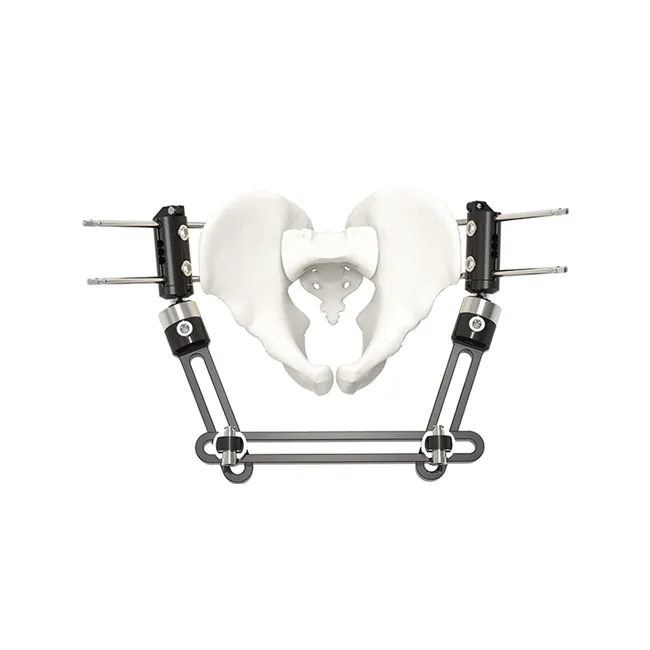Pelvic Fragment External Fixator: A Comprehensive Guide
The pelvic region is a complex structure that provides support for the upper body and protects the reproductive and digestive organs. Pelvic fractures can be severe and result in significant morbidity and mortality. Pelvic external fixators are one of the many treatment options for pelvic fractures. In this article, we will discuss the pelvic fragment external fixator, its indications, contraindications, techniques, complications, and outcomes.
Introduction
Pelvic fractures are a significant cause of morbidity and mortality in trauma patients. They can occur due to high-velocity accidents, falls from a height, or low-velocity trauma. The pelvic region has a complex anatomy with multiple bony structures, and fractures can result in significant displacement, instability, and hemorrhage. Pelvic external fixators are one of the many treatment options for pelvic fractures. They provide stability, support, and alignment of the pelvic bones while allowing early mobilization.
Indications
Pelvic external fixators are indicated in the following situations:
Pelvic ring disruption with displacement or instability
Open pelvic fractures
Acetabular fractures with displacement or comminution
Complex fractures involving the sacroiliac joint
Concomitant injuries that preclude surgery
Contraindications
Pelvic external fixators are contraindicated in the following situations:
Severe soft tissue injury or infection
Pelvic instability that cannot be adequately reduced
Vascular injury that cannot be controlled
Concomitant injuries that preclude external fixation
Technique
The pelvic external fixator consists of two main components: the pins and the connecting rods. The pins are inserted into the iliac crest and the supra-acetabular region of the pelvis under fluoroscopic guidance. The pins should be placed perpendicular to the bone surface and at least 2 cm away from the neurovascular structures. The connecting rods are then attached to the pins and adjusted to achieve the desired reduction and alignment. The reduction should be assessed intraoperatively using fluoroscopy and adjusted as needed.
Complications
Pelvic external fixators are associated with several complications, including:
Pin tract infection
Pin loosening or breakage
Rod migration or displacement
Neurovascular injury
Pressure sores
Loss of reduction or alignment
Sexual dysfunction
Outcomes
Pelvic external fixators have been shown to be effective in stabilizing pelvic fractures and improving patient outcomes. Early mobilization and weight-bearing can be achieved, resulting in reduced hospital stay, improved pain control, and decreased morbidity. However, the complication rate is high, and careful patient selection, proper pin placement, and close monitoring are essential to achieve optimal outcomes.
Conclusion
Pelvic external fixators are a valuable tool in the management of pelvic fractures. They provide stability, support, and alignment while allowing early mobilization. Proper patient selection, careful pin placement, and close monitoring are essential to achieve optimal outcomes.
FAQs
What is a pelvic external fixator? A pelvic external fixator is a device used to stabilize and align the bones of the pelvis in patients with pelvic fractures.
How is a pelvic external fixator inserted? The pins are inserted into the iliac crest and the supra-acetabular region of the pelvis under fluoroscopic guidance.
What are the indications for a pelvic external fixator? Pelvic external fixators are indicated in pelvic ring disruption with displacement or instability, open pelvic fractures, acetabular fractures with displacement or comminution, complex fractures involving the sacroiliac joint, and concomitant injuries that preclude surgery.
English
Français
Русский
Español
العربية
Português
Deutsch
italiano
日本語
한국어
Nederlands
Tiếng Việt
ไทย
Polski
Türkçe
አማርኛ
ພາສາລາວ
ភាសាខ្មែរ
Bahasa Melayu
ဗမာစာ
தமிழ்
Filipino
Bahasa Indonesia
magyar
Română
Čeština
Монгол
қазақ
Српски
हिन्दी
فارسی
Kiswahili
Slovenčina
Slovenščina
Norsk
Svenska
українська
Ελληνικά
Suomi
Հայերեն
עברית
Latine
Dansk
اردو
Shqip
বাংলা
Hrvatski
Afrikaans
Gaeilge
Eesti keel
Māori
नेपाली
Oʻzbekcha
latviešu
অসমীয়া
Aymara
Azərbaycan dili
Bamanankan
Euskara
Беларуская мова
भोजपुरी
Bosanski
Български
Català
Cebuano
Corsu
ދިވެހި
डोग्रिड ने दी
Esperanto
Eʋegbe
Frysk
Galego
ქართული
guarani
ગુજરાતી
Kreyòl ayisyen
Hausa
ʻŌlelo Hawaiʻi
Hmoob
íslenska
Igbo
Ilocano
Basa Jawa
ಕನ್ನಡ
Kinyarwanda
गोंगेन हें नांव
Krio we dɛn kɔl Krio
Kurdî
Kurdî
Кыргызча
Lingala
Lietuvių
Oluganda
Lëtzebuergesch
Македонски
मैथिली
Malagasy
മലയാളം
Malti
मराठी
ꯃꯦꯇꯥꯏ (ꯃꯅꯤꯄꯨꯔꯤ) ꯴.
Mizo tawng
Chichewa
ଓଡ଼ିଆ
Afaan Oromoo
پښتو
ਪੰਜਾਬੀ
Runasimi
Gagana Samoa
संस्कृत
Gaelo Albannach
Sepeti
Sesotho
chiShona
سنڌي
Soomaali
Basa Sunda
Wikang Tagalog
Тоҷикӣ
Татарча
తెలుగు
ትግንያውያን
Xitsonga
Türkmençe
संस्कृत
ئۇيغۇرچە
Cymraeg
isiXhosa
ייִדיש
Yorùbá
isiZulu



































